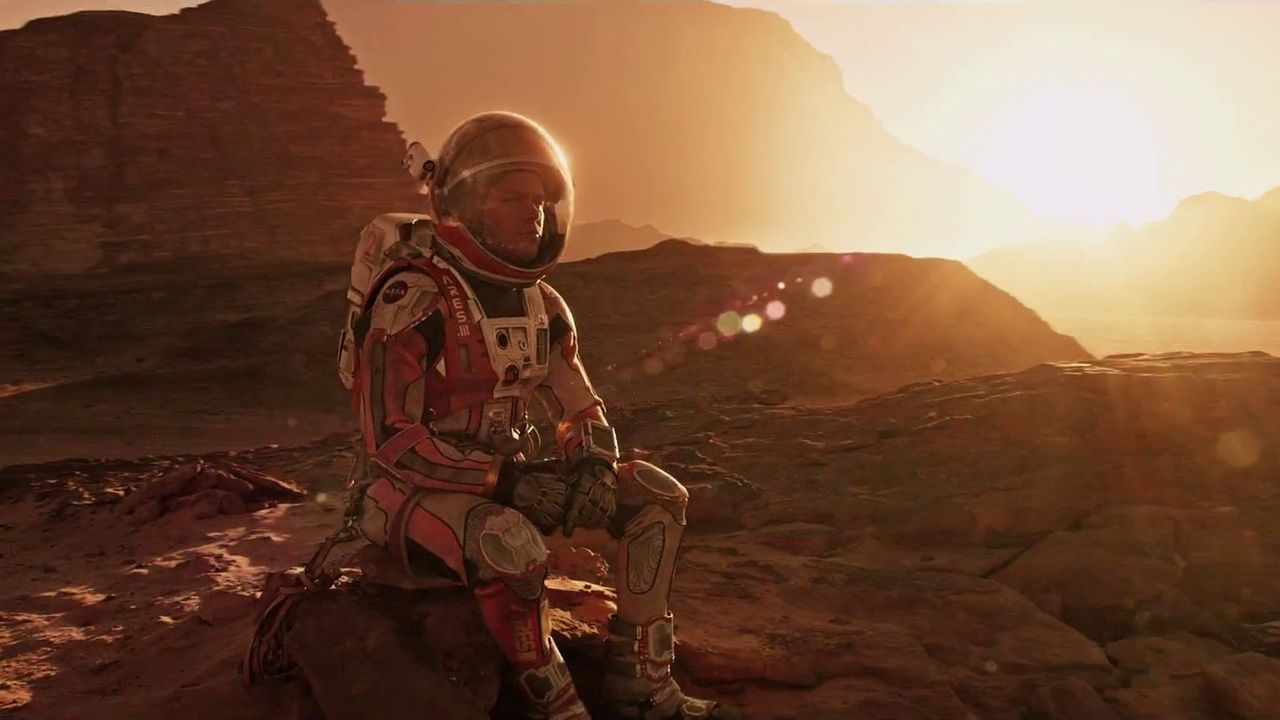By the end of The Martian, more than anything else, my wife and I were both struck by the clear vision of the way forward for man, an almost utopian vision grounded in a faith in science. The problem is that the vision ignores the nature of man.
(Warning: If you haven’t seen The Martian, this article is a spoiler.)
The basic plot of the movie, as you probably already know, is that a Mars mission is forced to quickly flee the planet due to a sand storm. In the chaos, the crew leave a man behind (Matt Damon) who was presumed dead. The rest of the movie is focused on NASA discovering that the abandoned astronaut is alive, how he survives, and the various rescue efforts to get him back to Earth. In the end, as is true for most typical Hollywood stories, the hero is rescued and everyone lives happily ever after.
That “happily ever after” part is worth discussing. The end of The Martian seems to present a message about the world coming together in the name of science to save an American astronaut and then ushering in a new era of exploration and progress. Hints of it are even in the film synopsis:
“With only a meager amount of supplies, the stranded visitor must utilize his wits and spirit to find a way to survive on the hostile planet. Meanwhile, back on Earth, members of NASA and a team of international scientists work tirelessly to bring him home, while his crew mates hatch their own plan for a daring rescue mission.” (Bold added.)
The first NASA attempt to rescue Matt Damon’s character went terribly wrong with the probe disintegrating shortly after launch. After that scene, we shift to China where the Chinese decide to offer the Americans a secret booster so that one more rescue attempt can be made. Here’s how it’s described in Wikipedia:
“The China National Space Administration offers NASA the Taiyang Shen, a classified booster that can carry a payload to Mars. Meanwhile, JPL astrodynamicist Rich Purnell devises a trajectory to send Hermes back to Mars more quickly, using the Chinese booster to instead resupply it for an additional eighteen months.”
The clue as to the subtle, yet not-so-subtle message comes during the Chinese discussion over whether or not they’ll let the Americans know the booster exists and then if they’ll let the Americans use it. The critical moment occurs when the head of the China National Space Administration decides that the Chinese will put aside nationalism and join with the Americans in the name of science – literally.
From there, things progress quickly. The international team of scientists unite for the cause, the second booster launch is successful, everyone maths and sciences together, there’s some personal bravery, and then all of the astronauts return home. The movie ends with the astronauts back on earth living out the next stages of their lives while watching the launch of the next shuttle to Mars. In the background, the song “Love Train” plays as we move from one happy scene to another.
Throughout the movie, there are lots of “yeah, science!” moments, both in the dialogue and the imagery. Admittedly, if and when we’re able to land a shuttle on Mars due to man’s scientific and mathematical knowledge, that will be utterly amazing, a “yeah, science!” moment, indeed.
Curiously, there are a few references to religion in the piece with questions about whether or not someone believes in God, Matt Damon’s character whittling on a wooden crucifix for fuel for a fire, and some random comments about needing God’s help if he exists. But overall, the emphasis of the movie is not on any need for the supernatural, but rather on man’s ability to overcome all obstacles through scientific and mathematical knowledge and the need to unite to do so.
But will the world really unite together around science in a “love train”?
Quite often we see a sort of faith in science in a lot of discussions and commentary around the web. Some have referred to it as ‘scientism’. The message essentially goes that we need to leave any mythological belief in the supernatural behind and pursue the only truth that we can know: science. Progress is somewhat defined around societies uniting around the ethos that can be discovered by science. The hope is that with religion and superstition gone, we can actually progress and evolve as people and as a species.
While we may want to unite under a common goal and, if we could, mankind might usher in a new era of peace and prosperity, the likelihood of uniting all men around science seems to ignore the very real nature of man that has been the focus of philosophy and religion.
Even in The Martian, man’s nature and division into factions cannot be ignored. Within NASA there were factions based on disagreements. Those factions ultimately lead to the astronauts on the Ares rebelling against NASA, looping around Earth, and going back to Mars to rescue Matt Damon’s character. While things turned out okay in the movie, real life is often quite different. Division and factions can often lead to violence and even war.
Humorously, even the name of the space shuttle, Ares, hints at the problem of factions. If you recall, Ares is the Greek god of war. From GreekMythology.com,
“[Ares] represented the raw violence and untamed acts that occurred in wartime, in contrast to Athena, who was a symbol of tactical strategy and military planning.
He was disliked by both his parents. Whenever Ares appeared in a myth, he was depicted as a violent personality, who faced humiliation through his defeats more than once. In the Iliad, it is mentioned that Zeus hated him more than anyone else; Ares was also on the losing side of the Trojan War, favoring the Trojans. He was the lover of his sister, Aphrodite, who was married to Hephaestus. When the latter found out about the affair, he devised a plan and managed to humiliate both of them. The union of Ares and Aphrodite resulted in the birth of eight children, including Eros, god of love.
…
When Ares went to war, he was followed by his companions, Deimos (terror) and Phobos (fear), who were the product of his union with Aphrodite.”
Even if we were to discard what some label as mythical beliefs and old religions to unite around science, it’s hard to believe that the passions represented in the story of Ares and visible even in The Martian, wouldn’t lead to factions, strife, and eventually division. While we can hope for progress through science, we may want to heed the ancient warnings about human nature. Unfortunately, Ares lurks in the hearts of all men.
















Leave a Comment
Your email address will not be published. Required fields are marked with *